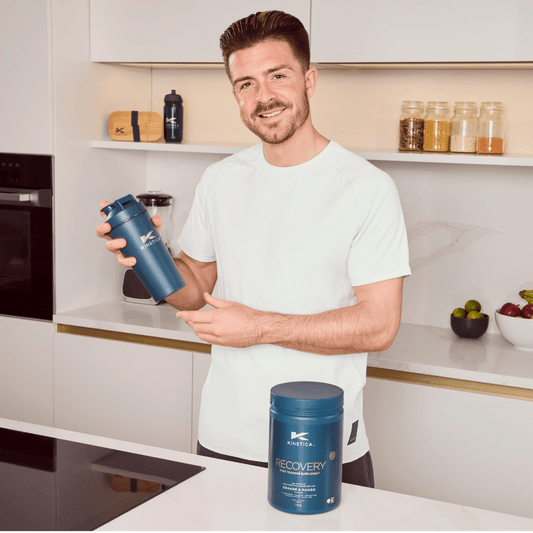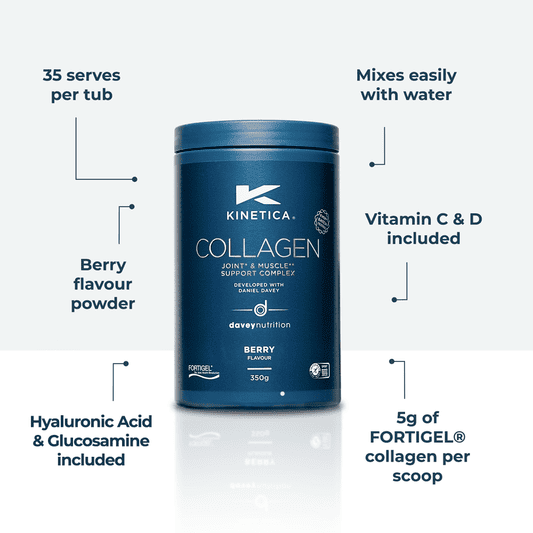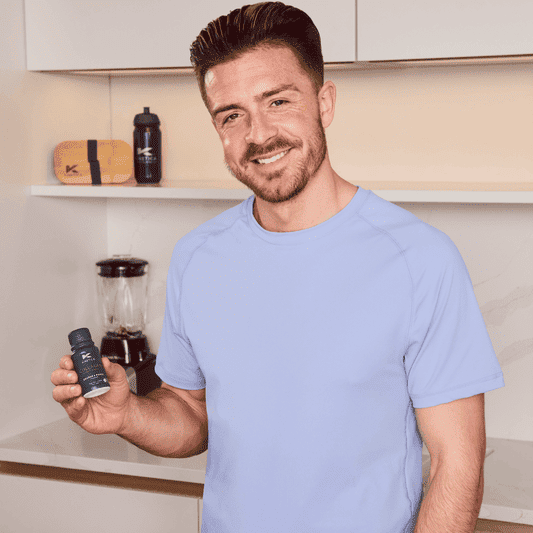The Endurance Athlete's Diet: Fuelling for Success in Marathons & Beyond

In many respects, endurance athletes are a whole different breed of sportsperson. And diet is just one of the many facets of training you need to master to reach your goals. Learn all about fuelling for success with Kinetica Sports in no time with our article recap…
- The importance of proper fuelling: we cannot stress enough that, as endurance athletes, you need the proper nutrition in your diet to succeed. From training to race day, nutrition is essential.
- Smashing your macros: we explore how macronutrients matter to endurance athletes. This includes getting the right amount of carbs for sustained performance during endurance sports, ensuring your protein intake is enough for consistent muscle growth and repair, and making sure you don’t skip fat entirely.
- Remembering the micros: micronutrients are just as important as part of a balanced diet for endurance athletes. Collagen, B vitamins, antioxidants and anti-inflammatories all play important roles in endurance diets.
- Strategic hydration: understand that staying hydrated, with both water and electrolytes, is key to sustaining your performance and maintaining your overall health.
Endurance athletes are a different breed in many respects. You must plan training meticulously, be disciplined with long training sessions, train regardless of the weather, and bank training and recovery amid a busy life. As far as fitness goes, endurance training is the real deal.
Whether preparing for your first marathon, training for a triathlon, or taking on an ultra, we at Kinetica Sports salute you. We also want to help you. In this post, I’ll share some core nutrition strategies to support your training, recovery, and performance. Naturally, a ton could be written here—this post is about giving insight into the fundamentals.
The Physiological Challenges of Endurance Training
Endurance training is hard. A marathon requires you to run 26 miles (42.195 km), which is an extraordinary achievement, regardless of pace. An ultra-marathon goes beyond that and can be as long as 100 miles (160.93km) or even longer – such as the so-called ‘Self-Transcendence’ race that covers 3100 miles. This distance is bananas when you take a moment to think about it. It’s like going from London to Cairo on foot.
What happens in the body when you push it this far? As you can imagine, quite a lot. There are obvious issues like muscle, tendon and joint injuries, that come about as a by-product of overuse. Research suggests that about 40% of trainees experience this kind of injury preparing for events(Kakouris, Yener et al. 2021). This is one reason why having adequate mobility, stability, and strength in the lower body is essential.
However, endurance athletes also experience other issues. For example, research into ultra-marathon running has observed several areas of maladaptation, such as blunted immunity, digestive dysfunction, impaired kidney function, high levels of cortisol, and a drop in anabolic hormones like testosterone (Knechtle and Nikolaidis 2018).None of this is written to dissuade anyone from endurance training. The same authors note that these negative changes are short-term and transient, and systems should return to normal with adequate recovery. However, it is worth understanding at a conceptual level that endurance training for marathons and beyond is a global stress on the body that goes beyond musculoskeletal.
It's also a good reminder that health and fitness are not the same. Just because someone is super fit does not mean they are healthy. In this respect, if you are training for big endurance events like marathons and ultras, it’s worth getting standard blood tests done with your doctor in the run-up to maximise fitness gains while also keeping a protective eye on your health (O'Keefe, Torres-Acosta et al. 2020).
Nutritional strategies for endurance training
The beautiful thing is that nutrition can make a massive difference in this equation. Diet, fluid intake, and timely supplementation can be a fantastic bridge, supporting both your health and your fitness as you prepare for the big day.
To put this into context, let’s reverse-engineer success and look at what the fastest endurance athletes do in their training to prepare for a marathon. Once you know what’s required to be successful, you can build appropriate nutrition strategies to facilitate training and recovery.
Research shows that the fastest amateur marathon runners have a better VO2 max, running economy and threshold before hitting their lactate threshold (Gordon, Wightman et al. 2017). In other words, they have a bigger and more efficient aerobic engine, their body can use its resources more effectively to push more.
What’s important about this insight is how they develop that aerobic engine. There are many training strategies we can leverage to improve our fitness, such as long runs, threshold (tempo) runs, HIIT training, Fartlek, Tempo intervals, VO2 max intervals, lactate tolerance training, and sprints.
Yet, a stand-out characteristic of elite amateur and professional marathon runners is the sheer volume of training performed at low intensity (Gordon, Wightman et al. 2017, Haugen, Sandbakk et al. 2022). Amateurs who finish a marathon in under three hours typically perform 92km of running per week, whereas those who take over 4.5 hours to complete a marathon accumulate 46.5km. You can see this below:

Pro endurance athletes follow a similar trend. For example, a study into the training characteristics of world-class distance runners found the world’s best marathon runners complete about 160 to 220km of distance each week, about 80% of which is performed at a low intensity (Haugen, Sandbakk et al. 2022).
Why does this matter from a nutrition perspective? Because once you know how to shape your training, you can build your nutrition strategies around it. Let’s break this down into three practical buckets: macronutrients, micronutrients and hydration.
Macronutrients for endurance training
As you may well know, there are three core macronutrients: carbohydrates, protein and dietary fats. Each plays its role in supporting us in endurance training.
Carbohydrates: Carbs are your primary fuel source for endurance training, even when doing a lot of training at a lower intensity (Thomas, Erdman et al. 2016). The weight of research shows that eating a moderate-to-high carbohydrate diet is vital to offset the effects of long-term, training-induced glycogen depletion (Tiller, Roberts et al. 2019).
A good starting point is 5-12 grams of carbohydrates per kilo of body weight per day, which you can adjust based on whether your exercise duration is moderate (about 60 minutes) or very high (four hours or more). This carbohydrate level helps to ensure muscle and liver glycogen needs are satisfied for high-volume training during the week.
Tip: If you're about to do an endurance session, Kinetica Sports Energy Carbohydrate Powder is a great choice for fuelling. It contains 41 grams of carbohydrates plus B vitamins central to cell energy production.
Protein: With a focus on carbohydrates, it’s common for many endurance athletes to forget about the importance of daily protein intake. But, as you can imagine, we must take on adequate protein each day to offset muscle damage and mechanical stress (Kato, Suzuki et al. 2016). Blood tests after endurance events show elevated creatine kinase, lactate dehydrogenase and creatine phosphokinase, representing biomarkers of muscle breakdown and damage (Shin, Park et al. 2016).
With this in mind, aim for a minimum of 1.6 grams of protein per kg of body weight per day (Tiller, Roberts et al. 2019). In times of unaccustomed training load, increased demands or signs of blunted recovery, this requirement may need to go up to 2.5 grams of protein per kg of body weight per day. So, if you weigh 55kg, that’s between 88g to 137g of protein needed daily. In context, a 170g salmon fillet might contain about 40 grams of protein.
Tip: If you struggle to consume your protein requirements from food alone, supplementation can help. Kinetica Sports Whey, Clear Whey, and Plant Protein powders provide highly absorbable sources of amino acids to stimulate muscle repair, recovery and muscle protein synthesis.
Fats: Consuming adequate dietary fat is important for optimal health and performance outcomes. For example, the absorption of vitamins A, D, E, and K relies on adequate dietary fat, and we absolutely need these for a well-functioning immune system. As such, research recommends avoiding a diet that contains less than 20% of your calories from dietary fat (Vitale and Getzin 2019).
Micronutrients for endurance training
A well-balanced diet is important to ensure that we take on sufficient vitamins, minerals and phytonutrients central to health. In the case of endurance training, it’s worth paying particular attention to nutrient status as gaps here can play havoc with mitochondrial health, which in turn saps our energy and endurance capacity.
Research analysing the dietary habits of endurance athletes supports these observations, with the majority displaying micronutrient deficits across the board (Moss, Kreutzer et al. 2023). 97% of endurance athletes were not getting the required omega-three fats in their diet, 94% had insufficient vitamin D, 71% had less than ideal B5, 57% were taking on too little magnesium, and other minerals (Chromium, Molybdenum, Choline and Manganese were also significantly compromised).
Anecdotally, having performed a lot of laboratory testing with athletes over the years, I commonly see people requiring higher levels of B vitamins, magnesium, vitamin C and plant-based antioxidants, such as turmeric. This makes sense physiologically, as these nutrients are involved in cellular energy production and recovery from strenuous work.
Tip: A good place to start here is the Collagen Shot from Kinetica Sports because it contains excellent musculoskeletal support (20g of collagen plus glucosamine sulphate and chondroitin sulphate), turmeric, black pepper, and vitamin C.
Hydration strategies for endurance training
A final point worth emphasising is fluid intake. This is a complex topic because many variables can influence how much water and electrolytes are required for endurance training, such as body weight, ambient temperature, sweat rate, sweat-rate sodium content, exercise intensity, kidney function, and more.
A key goal should be to prevent dehydration, but also overhydration too. The latter is just as much of an issue because exercise-associated hyponatremia (low blood sodium levels due to high fluid intake) can negatively affect health (Klingert, Nikolaidis et al. 2022).
From a practical standpoint, there are a number of things you can do.
- Drink high-quality mineral water a little and often throughout your normal day, regardless of training.
- Monitor the colour and smell of your urine. If it is darker than straw-coloured and has a smell, you are likely dehydrated.
- If you train most days, get used to having an electrolyte daily to ensure adequate intake of nutrients required for fluid balance. Kinetica Sports Electro-C can be a refreshing addition to your day to help here.
- Understand the fluid and electrolyte requirements that will be elevated when running in hot or humid conditions.
- Know that taking on fluid volume greater than lost in training is necessary to fully restore water balance.
- Begin with an initial hydration plan of 400-800ml per hour while endurance training and adjust as needed. Do not be shy about adding a sports drink with sodium to support energy and hydration status.
These are generalised points from the research and a great place to start looking after your hydration status (Knechtle and Nikolaidis 2018, Tiller, Roberts et al. 2019, Vitale and Getzin 2019, Klingert, Nikolaidis et al. 2022, Moss, Kreutzer et al. 2023).


















